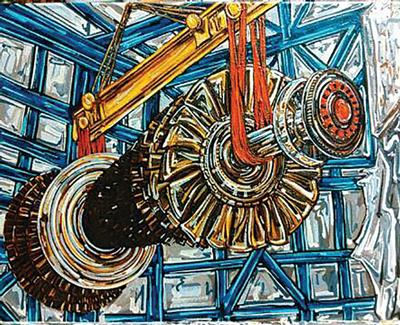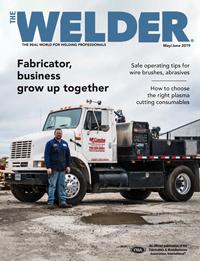Owner, Brown Dog Welding
- FMA
- The Fabricator
- FABTECH
- Canadian Metalworking
Categories
- Additive Manufacturing
- Aluminum Welding
- Arc Welding
- Assembly and Joining
- Automation and Robotics
- Bending and Forming
- Consumables
- Cutting and Weld Prep
- Electric Vehicles
- En Español
- Finishing
- Hydroforming
- Laser Cutting
- Laser Welding
- Machining
- Manufacturing Software
- Materials Handling
- Metals/Materials
- Oxyfuel Cutting
- Plasma Cutting
- Power Tools
- Punching and Other Holemaking
- Roll Forming
- Safety
- Sawing
- Shearing
- Shop Management
- Testing and Measuring
- Tube and Pipe Fabrication
- Tube and Pipe Production
- Waterjet Cutting
Industry Directory
Webcasts
Podcasts
FAB 40
Advertise
Subscribe
Account Login
Search
Inspired to “normalize” women in the workplace: Meet welder and artist Melissa Gillespie Davis
Laid-off Siemens AG metal fabricator becomes welding instructor
- By Josh Welton
- May 24, 2019
- Article
- Arc Welding
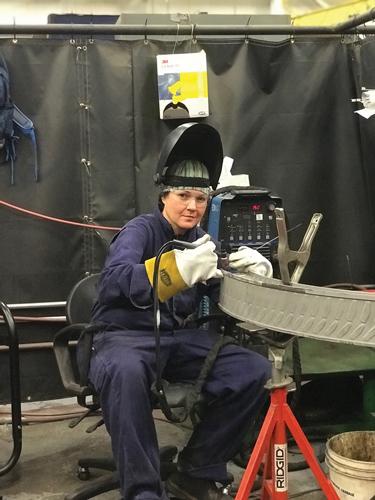
Melissa Gillespie Davis has spent the last 17 years repairing power turbine engines for Siemens. Now that the company has shut its doors, she is focused on a new path: becoming a welding instructor. In addition to being an accomplished welder, Gillespie Davis also is a talented artist who draws inspiration from women in the workplace.
Over the last few years we’ve been featuring young, blue-collar workers in our Still Building America blog series at thefabricator.com. Once in a while a story leaps out at me, and this is one of those.
My wife Darla shared Melissa Gillespie Davis’ industrial paintings with me, and they stopped me cold. Themes of tradeswomen, machinery, empowerment, and especially welding really stood out to me. Soon we found that Melissa herself is a union welder, and her story is one of will, talent, intelligence, and a good heart. She’s certainly a person to follow.
JW: Could you explain what kind of work you do? What got you started?
MGD: After 20 years of welding and 17 repairing power turbine engines, my path has taken a slight turn. Siemens announced in October that it will be shutting down our shop after more than 70 years in service.
I knew exactly what I wanted to do, so I signed up at Lone Star College to get my AAS degree in welding technology so that I can become a welding instructor. I felt it was time to give back to a career that has provided so much for me and to focus on reaching out to women specifically. It really is way past time to normalize women in the trades.
I decided to become a welder while I was working three jobs trying to support my young son. I needed a job that would cover all the bills; put me on a manageable, steady schedule; and would not require tons of schooling to start. Plus, as an artist, I work with my hands and see welding as a form of sculpture.
JW: Who were your career influences, and who has impacted your life?
MGD: My father taught me how to weld (he was a machinist) in the garage. It was just enough to spark my interest. I have always identified with strong women in general, and feel the sisterhood of trailblazers.
JW: What type of background and training do you have?
MGD: After my dad showed me the basics, I looked through the Yellow Pages and found a tiny school in Pasadena, Texas. It was actually a test lab for welders testing for jobs. Nine months later I had certs for stick structure and pipe, and even some time with TIG, just enough to land a job.
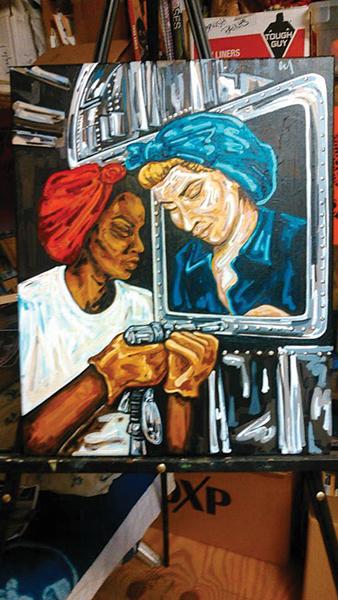
Gillespie Davis wants her art to help normalize women in the workplace. “It should be normal. It really should not seem strange that a woman can work with her hands and make some good money.”
JW: What is your favorite part of the job?
MGD: My favorite thing about welding, honestly, is that you don’t have to deal with customers. The physical aspect is great because you stay strong, crews become family, and the challenge of perfecting your craft makes the day go by quickly. And the money makes it even more worth it. Being a union member, my pay was exactly the same as my co-workers.’
JW: What is the most challenging part of your job?
MGD: The most challenging part is there’s just so much to know about metal and welding. You can be a master at one aspect and a total rookie at something else. But welders relax into a role of figuring out as many different techniques as possible. Metal is fascinating.
JW: What’s the future goal for your career?
MGD: After the announcement of the shop closure, I knew it was time to pounce on the dream I’d been aware of for years: to actively bring women into the workforce. I’ve always promoted that idea through my paintings, but now is the time to own that dream.
I’m in my first semester of a two-year degree program that will allow me to qualify for a teaching career. The college I attend has already expressed great interest in hiring me just based on my job experience and school performance, so I will probably start there as an instructor, learn as much as I can from them, and then branch off and start teaching in a shop that my husband (also a welder and machinist) and I are building on our land in Texas. I’m pretty stoked about this new direction. It’s been building up for so long in my mind and now it’s happening.
JW: Aside from being a welder, you are also an amazing artist. What is your art background?
MGD: Art has always been a major part of my life. It’s just a must for me. I went to Kansas City Art Institute for one year and then decided not to continue. I knew I’d always do art with or without schooling. I have a small studio that my husband built for my painting, but I’m superstoked for our shop to go up so it can explode!
JW: My wife Darla became tuned in to your Women Workers artwork through a post in the Welding
Women Facebook group. What inspired you to do
artwork featuring women in the trades?
MGD: My art has definitely been influenced by my profession. I have done many paintings of machinery, tradeswomen (my personal favorite), and designs for departments in the shop.
The inspiration for my Women Workers art series is really just from a desire to normalize women in the workforce. Art can be a powerful tool for creating this reality. As far as the machines and turbine engine components, they’ve been such a part of my daily life for so long, and I’m pretty fascinated by the patterns of the blades and the way piecing them together creates an energy-making machine.
Now that I’ve changed directions, I’m glad I have the drawings as sort of a record of the work we did. I was invited to show my art of women in the workplace at the Electrical Workers Minority Caucus, an IBEW conference. All of the paintings sold the weekend that I was laid off! That inspired me to do more to engage in conversation regarding women in the trades.
JW: We love the phrasing that you’ve used: Normalize women in the workplace.
MGD: It should be normal. It really should not seem strange that a woman can work with her hands and make some good money. But it is strange. In 2019, people are still not ready. At least we get the easy job. I am eternally grateful to our grandmothers, who are the real trailblazers.
JW: That gratitude is reflected in your artwork. Do you find any similarities between painting and welding?
MGD: Many similarities, mainly just as far as being able to bring ideas to life and the skills that go along with hand-eye coordination. The mental focus and drive are very similar in that you sort of lose yourself in your work.
JW: Do you sell your paintings or accept commission projects?
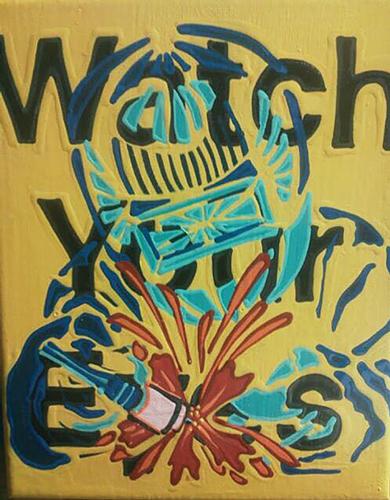
Painting and welding have many similarities for Gillespie Davis. Both allow you to bring ideas to life and require the hand-eye coordination and mental focus.
MGD: I do sell my work, but I really don’t do commissions. I find it takes the joy out of the work to try to match someone else’s vision. I sell my own work regularly.
JW: What advice would you give those who are interested in following your path or just need a little encouragement?
MGD: Honestly, just do it. That goes for anything. Part of the process of getting what you want out of life is just scrapping for it and getting in there any way you can. Stuff is rarely handed to us. We have to focus on it and make it happen. Get knocked down and get right back up. Start at the bottom. Do the hard stuff. Relentless forward progress (ultrarunners motto).
Follow Melissa on Instagram: @melgida
About the Author

About the Publication
subscribe now

The Welder, formerly known as Practical Welding Today, is a showcase of the real people who make the products we use and work with every day. This magazine has served the welding community in North America well for more than 20 years.
start your free subscription- Stay connected from anywhere

Easily access valuable industry resources now with full access to the digital edition of The Fabricator.

Easily access valuable industry resources now with full access to the digital edition of The Welder.

Easily access valuable industry resources now with full access to the digital edition of The Tube and Pipe Journal.
- Podcasting
- Podcast:
- The Fabricator Podcast
- Published:
- 04/16/2024
- Running Time:
- 63:29
In this episode of The Fabricator Podcast, Caleb Chamberlain, co-founder and CEO of OSH Cut, discusses his company’s...
- Industry Events
16th Annual Safety Conference
- April 30 - May 1, 2024
- Elgin,
Pipe and Tube Conference
- May 21 - 22, 2024
- Omaha, NE
World-Class Roll Forming Workshop
- June 5 - 6, 2024
- Louisville, KY
Advanced Laser Application Workshop
- June 25 - 27, 2024
- Novi, MI
























